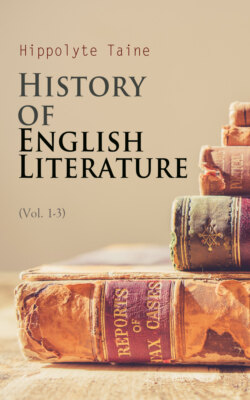Читать книгу History of English Literature (Vol. 1-3) - Taine Hippolyte - Страница 4
На сайте Литреса книга снята с продажи.
Table of Contents
ОглавлениеINTRODUCTION
I. Historical documents serve only as a clue to reconstruct the visible individual
II. The outer man is only a clue to study the inner invisible man
III. The state and the actions of the inner and invisible man have their causes in certain general ways of thought and feeling
IV. Chief causes of thought and feeling. Their historical effects
V. The three primordial forces.—Race
VI. History is a mechanical and psychological problem. Within certain limits man can foretell
VII. Law of formation of a group. Examples and indications
VIII. General problem and future of history. Psychological method. Value of literature. Purpose in writing this book
BOOK I.—THE SOURCE CHAPTER FIRST - The Saxons
SECTION I.—The Coast of the North Sea
SECTION II.—The Northern Barbarians
SECTION III.—Saxon Ideas
SECTION IV.—Saxon Heroes
SECTION V.—Pagan Poems
SECTION VI.—Christian Poems
SECTION VII.—Primitive Saxon Authors
SECTION VIII.—Virility of the Saxon Race
CHAPTER SECOND - The Normans
SECTION I.—The Feudal Man
SECTION II.—Normans and Saxons Contrasted
SECTION III.—French Forms of Thought
SECTION IV.—The Normans in England
SECTION V.—The English Tongue—Early English Literary Impulses
SECTION VI.—Feudal Civilization
SECTION VII.—Persistence of Saxon Ideas
SECTION VIII.—The English Constitution
SECTION IX.—Piers Plowman and Wyclif
CHAPTER THIRD - The New Tongue
SECTION I.—The First Great Poet
SECTION II.—The Decline of the Middle Ages
SECTION III.—The Poetry of Chaucer
SECTION IV.—Characteristics of the Canterbury Tales
SECTION V.—The Art of Chaucer
SECTION VI.—Scholastic Philosophy
BOOK II.—THE RENAISSANCE
CHAPTER FIRST - The Pagan Renaissance
Part I.—Manners of the Time
SECTION I.—Ideas of the Middle Ages
SECTION II.—Growth of New Ideas
SECTION III.—Popular Festivals
SECTION IV.—Influence of Classic Literature
Part II.—Poetry
SECTION I.—Renaissance of Saxon Genius
SECTION II.—The Earl of Surrey
SECTION III.—Surrey's Style
SECTION IV.—Development of Artistic Ideas
SECTION V.—Wherein Lies the Strength of the Poetry of this Period
SECTION VI.—Edmund Spenser
SECTION VII.—Spenser in his Relation to the Renaissance
Part III.—Prose
SECTION I.—The Decay of Poetry
SECTION II.—The Intellectual Level of the Renaissance
SECTION III.—Robert Burton
SECTION IV.—Sir Thomas Browne
SECTION V.—Francis Bacon
CHAPTER SECOND - The Theatre
SECTION I.—The Public and the Stage
SECTION II.—Manners of the Sixteenth Century
SECTION III.—Some Aspects of the English Mind
SECTION IV.—The Poets of the Period
SECTION V.—Formation of the Drama
SECTION VI.—Furious Passions—Exaggerated Characters
SECTION VII.—Female Characters
CHAPTER THIRD - Ben Jonson
SECTION I.—The Man—His Life
SECTION II.—His Freedom and Precision of Style
SECTION III.—The Dramas Catiline and Sejanus
SECTION IV.—Comedies
SECTION V.—Limits of Jonson's Talent—His Smaller Poems—His Masques
SECTION VI.—General Idea of Shakespeare
CHAPTER FOURTH - Shakespeare
SECTION I.—Life and Character of Shakespeare
SECTION II.—Shakespeare's Style—Copiousness—Excesses
SECTION III.—Shakespeare's Language And Manners
SECTION IV.—Dramatis Personæ
SECTION V.—Men of Wit
SECTION VI.—Shakespeare's Women
SECTION VII.—Types of Villains
SECTION VIII.—Principal Characters
SECTION IX.—Characteristics of Shakespeare's Genius
INDEX
